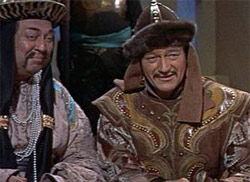Ballet as an International Language
Mao’s Last Dancer, the highest-grossing Australian movie of 2009, is a story about a Chinese ballet dancer who comes to America, and then refuses to return to his homeland. It was based on a memoir by the dancer in question, Li Cunxin.
Cunxin’s book has been very successful in itself: it has been published and marketed in more than 20 countries, and won the Christopher Award, an annual prize for works of art that “affirm the highest values of the human spirit.”
But on to the movie! Christopher Gordon wrote the original music in the score: This includes a lovely opening dominated by Chinese instrumentation such as the dizi flute.
 Much of the action of the movie takes place in Houston, Texas, in 1981, (and was filmed on location there), because the plot involves that city’s ballet company, of which Vice President and Barbara Bush were patrons.
Much of the action of the movie takes place in Houston, Texas, in 1981, (and was filmed on location there), because the plot involves that city’s ballet company, of which Vice President and Barbara Bush were patrons.
Die Fledermaus
We see a bit of a performance of Die Fledermaus, an opera by Johan Strauss II that contains a ballet sequence. The protagonist of the movie, in the manner of protagonists of a lot of show business centered movies, steps in when the member of the company who had been slated to dance in this sequence was not available. There is some panicked talk back stage about whether Li is up to it, and even whether his being Chinese (the dancer is described in the script of the opera as a Spaniard) disables him.
One character reminds another, though, that Marlon Brando played a Japanese villager in the classic 1956 movie, Teahouse of the August Moon. “Oh, I liked that movie,” is the only response, and the matter of Li’s physical rightness for the part is closed.
Back to our movie,
Mao’s Last Dancer
: Li does step in to play the Spanish dancer in the ballet sequence in Die Fledermaus, the show goes on, and proves a great success. A star is born. Unfortunately, I can’t find that particular scene from Mao’s Last Dancer on YouTube or elsewhere. But if you’d like to hear the music, by Johann Strauss, to which he was dancing: click here.
As it happens, Die Fledermaus (The flutter-mouse or The bat) is on most lists of standard repertoire for opera companies. If you haven’t seen a performance, it will be worth your while to be able to fake your way through discussions with those who have. For that purpose, I’ll give you a précis here.
It’s an opera in three acts. In Act One, a servant, Adele, receives a letter from her sister (who is in a ballet company) inviting her to a masked ball to be hosted by Prince Orlofsky. She is a maid who must receive leave from her employer, Gabriel von Eisenstein, to attend such a ball, so she pretends that the letter tells her that her aunt is very sick, and Eisenstein gives her leave.
 Eisenstein has his own troubles. He has been sentenced to eight days in prison for a minor offense, a sentence that has come about largely through the incompetence of his attorney Dr. Blind. I’ll insert here a gratuitous but amusing cartoon of an incompetent attorney at work in the 21st century.
Eisenstein has his own troubles. He has been sentenced to eight days in prison for a minor offense, a sentence that has come about largely through the incompetence of his attorney Dr. Blind. I’ll insert here a gratuitous but amusing cartoon of an incompetent attorney at work in the 21st century.
Eisenstein’s wife, Rosalinde, persuades her lover, Alfred, to pretend to be Eisenstein and go to prison to serve his time.
The ball, we learn, was orchestrated not by Orlofsky – though he is in on it – but by a friend of Eisenstein’s, or ex-friend, named Falke who is using it as a pretext to get revenge on Eisenstein for a slight done to him a year before. Falke’s plan is to have Eisenstein’s wife witness Eisenstein in indiscrete exchanges with other women. To this end, of course, he invites both husband and wife.
Yes, I know all that sounds complicated. What’s worse, it only gets us through Act One!
Act Two
In Act Two we’re at the ball, and we watch as Adele and her boss run into each other. Adele is pretending to be an actress. Eisenstein is amazed that she looks so much like his maid, who is of course with her aunt. At the idea that she may be a maid, the actress (maid) takes offense, leading to one of the better-known tunes of the opera, the “Laughing Song.”
Rosalinde arrives, playing an exotic Hungarian countess, and in that capacity elicits from Eisenstein the protestation that he is not married – and he gives the countess the gift of is watch.
 After all this comes the ballet – part of the entertainment that Prince Orlofsky (who of course is in on Falke’s machinations) has arranged for his party. In the original this began with a Spanish waltz, changing to music in the Scottish style, and finally something Russian.
After all this comes the ballet – part of the entertainment that Prince Orlofsky (who of course is in on Falke’s machinations) has arranged for his party. In the original this began with a Spanish waltz, changing to music in the Scottish style, and finally something Russian.
But in the long history of performances of this opera since April 1874, there have been lots of interpolated ballets at this point in the plot and party.
We needn’t take our plot summary any further, though we might add that Falke and Eisenstein are reconciled, as are Rosalinde and Eisenstein. All works out for the best in the Panglossian world of comic opera.
Mao’s Last Dancer
Likewise, Mao’s Last Dancer ends quite happily for ,most if not all of its characters. Li is married, refuses to return to China upon command, and receives the protection of the U.S. government in that refusal. Meanwhile, in China, the Gang of Four is arrested, a new regime less hostile to the art of the rest of the world comes to power, and in time Li is allowed to return to his homeland, and dance for his own family and his old friends in the village.
Ballet, as an international language, prevails over ideology.
A Final Word
 There were in the days of classic Hollywood a lot of instances of Caucasian actors playing east Asian roles. Sometimes this had a frankly ridiculous effect: John Wayne as Genghis Khan in The Conqueror, (1956) or Mickey Rooney marring an otherwise great movie, Breakfast at Tiffany’s, (1961) with a ridiculously stereotypical Japanese accent as Holly’s landlord, I. Y. Yunioshi. But in fairness it must be said that Marlon Brando as the interpreter, Sakini, in the movie version of Teahouse, was not a stereotypical ‘yellowface’ presentation. Brando brought his usual method-acting thoroughness to his portrayal of Sakini and was, in this respect, more like Yul Brynner than like Mickey Rooney.
There were in the days of classic Hollywood a lot of instances of Caucasian actors playing east Asian roles. Sometimes this had a frankly ridiculous effect: John Wayne as Genghis Khan in The Conqueror, (1956) or Mickey Rooney marring an otherwise great movie, Breakfast at Tiffany’s, (1961) with a ridiculously stereotypical Japanese accent as Holly’s landlord, I. Y. Yunioshi. But in fairness it must be said that Marlon Brando as the interpreter, Sakini, in the movie version of Teahouse, was not a stereotypical ‘yellowface’ presentation. Brando brought his usual method-acting thoroughness to his portrayal of Sakini and was, in this respect, more like Yul Brynner than like Mickey Rooney.
Also, the Americans of the plot, singing “Deep in the Heart of Texas” in the heart of Okinawa, are sufficient to justify the movie.


